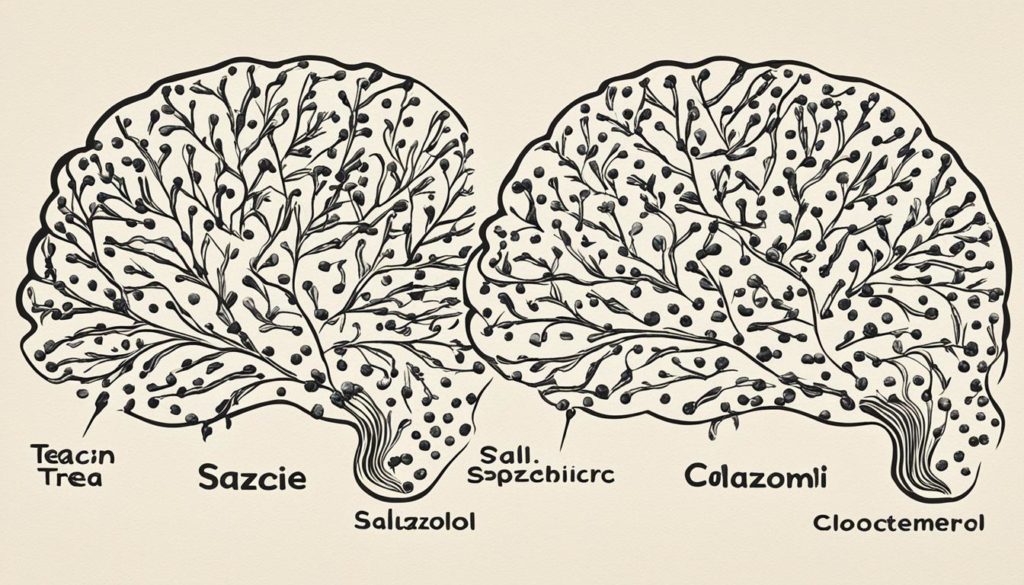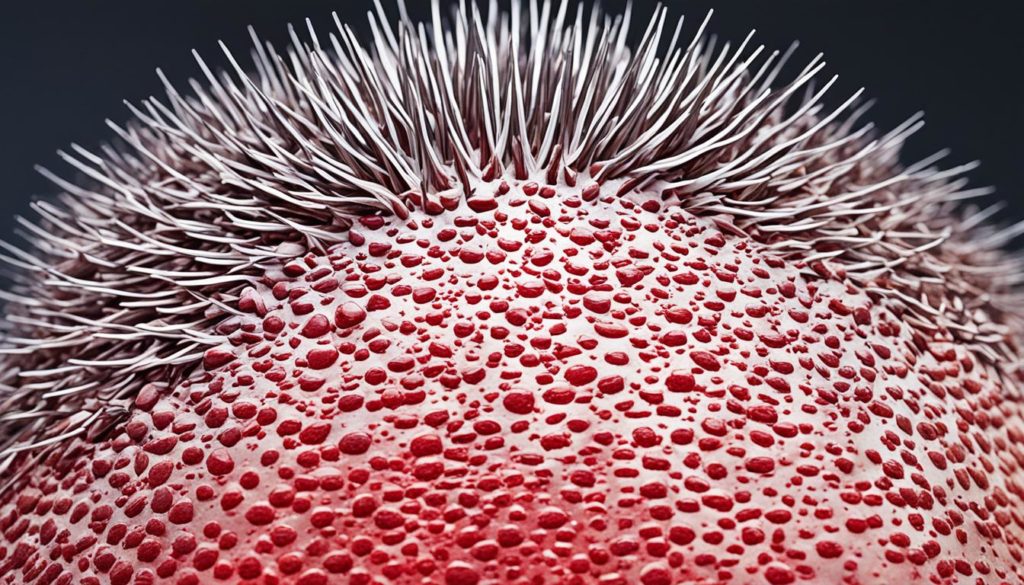About one in five Americans face scalp pimples at some time. These small, red bumps can be super annoying. They show up because of hormone changes, not cleaning the scalp well, or hair product buildup. Learning the causes and treatment methods is key for a healthy scalp.
Key Takeaways
- Scalp pimples are a common issue affecting one in five Americans.
- They can be caused by excess sebum production, hair product buildup, and poor scalp hygiene.
- Effective treatments include topical treatments, medicated shampoos, and natural remedies.
- Identifying scalp pimples correctly is essential for proper treatment.
- Prevention strategies focus on maintaining a daily scalp care routine and avoiding triggers.
Understanding Scalp Pimples
Scalp pimples, known as acneiform eruptions, form when hair follicles get blocked. They are similar to facial acne and appear as blackheads, whiteheads, papules, or cysts. Knowing how to spot scalp pimples is key to treating them right.

What are Scalp Pimples?
Scalp pimples are acne that occurs on the scalp. They happen when hair follicles get blocked, leading to inflammation or infection. It’s important to tackle the root causes of these pimples to avoid more breakouts.
Difference Between Scalp Acne and Regular Acne
Scalp acne and facial acne differ in where they appear and how they’re treated. Scalp acne is hidden by hair, which makes applying treatments tough. Hair products can also worsen scalp acne. Knowing this helps in finding the right treatment for scalp acne.
Common Causes of Scalp Pimples
Knowing why scalp pimples happen is key to stop them. Many things can lead to scalp pimples. It’s important to know and tackle these causes.
Excess Sebum Production
Too much sebum is a big reason for scalp acne causes. Our scalp has glands that make sebum to moisten the skin. But if they make too much, it can block hair roots. This blockage can help bacteria grow and cause pimples.
Hair Product Buildup
Hair products like conditioners and gels can also cause scalp acne. They can leave stuff behind that blocks pores and irritates the skin. It’s important to wash off hair products well to avoid this.
Poor Scalp Hygiene
Not washing your scalp well is another scalp acne cause. Not rinsing shampoo and conditioner properly can leave dirt and oil. This dirt and oil block follicles and help bacteria. Cleaning your scalp well can keep it healthy.

How to Identify Scalp Pimples
Scalp pimples can be a real bother. Correctly spotting them is key for the right fix. They cause itching, sore spots, and pustules on the scalp. These can feel like tender bumps under your hair. It’s crucial to tell them apart from issues like folliculitis or dermatitis.
Talking to an expert can clarify things. A dermatologist can tell if it’s acne or something else. This ensures you get the correct treatment.
Here’s how to spot scalp pimples:
- Itching: If it itches a lot, it might be a sign.
- Soreness: They often hurt when you touch them.
- Pustules: These are small, pus-filled bumps. They can look red and swollen.
If you think you have these pimples, getting the right diagnosis and treatment is key. Wrong treatment can make things worse. So, make sure to get a scalp acne solution suited to your specific issue. This can help ease symptoms and stop more pimples in the future.
| Symptom | Description |
|---|---|
| Itching | Persistent and usually uncomfortable sensation. |
| Soreness | Painful, especially when touching the affected area. |
| Pustules | Small, pus-filled bumps that can be red and inflamed. |
Effective Treatments for Scalp Pimples
Getting a clear scalp means picking the right treatments for you. Scalp pimples can be tough, but there are tested ways to tackle and stop them. Let’s look at different treatments that really help with this annoying problem.
Topical Treatments
Topical treatments are key for fighting scalp acne. They include ingredients like salicylic acid and benzoyl peroxide. These ingredients lessen inflammation and help avoid blocked pores. They offer a quick fix for scalp pimples.
Medicated Shampoos
Medicated shampoos are also very effective against scalp acne. Look for shampoos with ketoconazole or zinc pyrithione, great against fungal acne. Using these regularly keeps your scalp healthy, making them must-have scalp acne remedies.
Natural Remedies
For those who like natural options, things like tea tree oil are good. They fight mild scalp acne with their germ-killing properties. Adding natural remedies to your routine can really boost your fight against scalp pimples.
| Treatment Type | Key Ingredient | Effectiveness |
|---|---|---|
| Topical Treatments | Salicylic Acid, Benzoyl Peroxide | High |
| Medicated Shampoos | Ketoconazole, Zinc Pyrithione | Very High |
| Natural Remedies | Tea Tree Oil | Moderate |
Mixing different treatment methods often works best for scalp pimples. By picking the right products and remedies, you can control and prevent scalp acne well.
Professional Scalp Acne Treatment
When home treatments don’t work, turning to a professional can help. Dermatologists offer special treatments and medications. They pick what will work best for each person.
Dermatological Procedures
Doctors can do advanced treatments like light therapy and chemical peels. Light therapy uses special lights to kill bacteria and calm inflammation. It’s gentle and doesn’t involve surgery.
Chemical peels clean deep by peeling off the outer skin. This opens up pores and reduces spots. It’s another effective way to fight scalp acne.
Prescription Medications
Dermatologists might give strong medicine for tough acne. Oral antibiotics target the bacteria causing the problem. Retinoids, taken either as a cream or a pill, help skin renew itself. This stops new pimples.
Each person gets a plan made just for them. This is how doctors ensure the best results.
It’s important to get a doctor’s help for serious scalp acne. A dermatologist’s advice can lead to clear skin. They help keep your scalp healthy and free from pimples.
Preventing Scalp Breakouts
To keep your scalp breakout-free, stay consistent with your scalp care. Adding some smart scalp care tips to your daily life helps a lot to stop breakouts.
Daily Scalp Care Routine
Having a solid daily routine is key to avoiding scalp breakouts. Washing regularly gets rid of extra oil and buildup that can block pores. Choosing the right hair products for you helps keep everything balanced.
Adding a gentle scrub to your routine once or twice a week is good too. It clears away dead skin and other junk. This means your hair roots get air, stopping acne triggers from setting in.
Avoiding Trigger Factors
Knowing and staying away from things that trigger your scalp breakouts is very useful. Certain stuff in hair products may irritate or block your hair roots. Always know what’s going into your scalp care. Pick products that don’t block pores to keep them open.
Hormonal changes and stress might make scalp issues worse. Reduce stress with relaxation tricks and eat well to help your scalp. Some hairstyles that pull on your scalp may need changing too.
Seeing a dermatologist can give you customized scalp care tips and help figure out what’s causing your scalp acne.
Scalp Hygiene Tips
Keeping your scalp clean is key to stopping scalp pimples. Following top scalp care advice can lead to a healthy scalp without breakouts.
Proper Shampooing Techniques
It’s crucial to shampoo the right way for great scalp health. Use lukewarm water to keep the scalp’s oils balanced. A gentle scalp massage while shampooing removes extra oil and dirt.
Rinsing well makes sure no product stays on your scalp. This prevents problems caused by buildup.
Importance of Clean Hair Tools
Cleaning your hair tools often is vital for scalp cleanliness. It stops old oil and dirt from getting back on your scalp. Get into the routine of cleaning your brushes and combs to avoid scalp pimples.
| Scalp Care Activity | Recommended Frequency |
|---|---|
| Shampooing | 2-3 Times a Week |
| Sanitizing Hair Tools | Weekly |
| Scalp Massage | Daily |
Natural Remedies for Scalp Pimples
Exploring natural remedies can offer a kind and effective way to treat scalp pimples. These methods are often less harsh than chemical options. This makes them great for those with sensitive skin.
Tea Tree Oil
Tea tree oil is known for its antiseptic and antimicrobial effects. Using a diluted tea tree oil solution can lower inflammation and fight bacteria, making it a top choice for scalp acne. Always do a patch test before using it fully to avoid any bad reactions.
Aloe Vera
Aloe Vera is famed for its soothing and healing abilities. Putting Aloe Vera gel on the affected areas can ease irritated skin and help with healing. Adding Aloe Vera to your care routine is a great move for fighting scalp pimples.
Both tea tree oil and Aloe Vera offer great natural solutions for scalp pimples. They provide a different path from traditional treatments.
| Remedy | Benefits | Application |
|---|---|---|
| Tea Tree Oil | Antiseptic, Antimicrobial | Apply diluted solution, perform patch test first |
| Aloe Vera | Soothing, Healing | Apply gel directly, promotes healing |
Conclusion
In conclusion, getting rid of scalp pimples needs a complete strategy that focuses on fixing and stopping them. Knowing what causes them, like too much oil and hair products, is key. Spotting them early and using the right treatments can help lessen their impact.
There are many treatments available, from store-bought products to natural solutions. Some may prefer creams and special shampoos. Others might like using tea tree oil or aloe vera. Being consistent and patient is important for success.
Stopping new pimples on the scalp is also important. A good scalp care routine can help prevent them. This includes washing your hair often and keeping hair tools clean. These steps are crucial for a healthy scalp.
With the correct knowledge and actions, a healthy scalp is possible. By staying proactive and following these tips, you can beat scalp pimples. This leads to lasting comfort and a clearer head.
FAQ
What are scalp pimples?
Scalp pimples are small, inflamed bumps also known as scalp acne. They show up on your scalp. Causes include hormonal changes, hygiene practices, and irritants.
What’s the difference between scalp acne and regular acne?
The main difference is where they occur and how we treat them. Scalp acne is hidden by hair, making treatment hard. Regular acne usually shows up on the face or body.
What causes scalp pimples?
They’re often caused by too much oil, hair product buildup, and bad scalp hygiene. These factors can block pores. This leads to bacteria growth and scalp acne.
How can I identify scalp pimples?
Look for itching, pain, and pustules. Sometimes, you might need a professional to tell them apart from other conditions.
What are the effective treatments for scalp pimples?
Try treatments with salicylic acid or benzoyl peroxide. Medicated shampoos with ketoconazole or zinc work too. Natural remedies like tea tree oil can also help.
Are there professional treatments for scalp acne?
Yes, for tough cases, professionals can help. They might suggest light therapy, peels, or medication. Options include antibiotics or retinoids.
How can I prevent scalp breakouts?
Keep a good scalp care routine daily. Choose the right hair products. Wash your hair often. Also, avoid triggers like certain ingredients, hormonal changes, or stress.
What are some scalp hygiene tips?
Use lukewarm water and massage your scalp gently while shampooing. Rinse well. Keeping hair tools clean helps minimize acne risks.
What natural remedies are effective for treating scalp pimples?
Tea tree oil and Aloe Vera can be great. But, make sure to test them first to avoid reactions.


